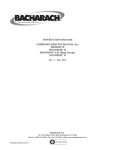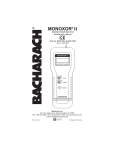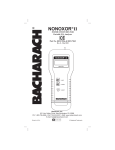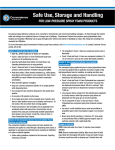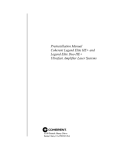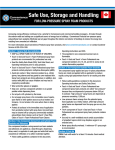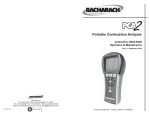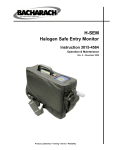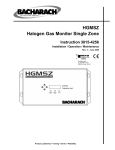Download Bacharach DIOXOR 19-7038 Specifications
Transcript
® DIOXOR II INSTRUCTION 19-9121 Portable SO2 Analyzer Part No. 19-7038 & 19-7043 Rev. 6 - April 2007 Bacharach, Inc. 621 Hunt Valley Circle, New Kensington, PA 15068 Ph: 724-334-5000 • Fax: 724-334-5001 • E-mail: [email protected] Web: www.bacharach-inc.com Printed in U.S.A. ® Registered Trademarks WARRANTY Bacharach, Inc. warrants to Buyer that at the time of delivery this Product will be free from defects in material and manufacture and will conform substantially to Bacharach Inc.’s applicable specifications. Bacharach’s liability and Buyer’s remedy under this warranty are limited to the repair or replacement, at Bacharach’s option, of this Product or parts thereof returned to Seller at the factory of manufacture and shown to Bacharach Inc.’s reasonable satisfaction to have been defective; provided that written notice of the defect shall have been given by Buyer to Bacharach Inc. within one (1) year after the date of delivery of this Product by Bacharach, Inc. Bacharach, Inc. warrants to Buyer that it will convey good title to this Product. Bacharach’s liability and Buyer’s remedy under this warranty of title are limited to the removal of any title defects or, at the election of Bacharach, to the replacement of this Product or parts thereof that are defective in title. All expendable items, such as electrochemical sensors, are warranted for a period of six months. THE FOREGOING WARRANTIES ARE EXCLUSIVE AND ARE GIVEN AND ACCEPTED IN LIEU OF (I) ANY AND ALL OTHER WARRANTIES, EXPRESS OR IMPLIED, INCLUDING WITHOUT LIMITATION THE IMPLIED WARRANTIES OF MERCHANTABILITY AND FITNESS FOR A PARTICULAR PURPOSE: AND (II) ANY OBLIGATION, LIABILITY, RIGHT, CLAIM OR REMEDY IN CONTRACT OR TORT, WHETHER OR NOT ARISING FROM BACHARACH’S NEGLIGENCE, ACTUAL OR IMPLIED. The remedies of the Buyer shall be limited to those provided herein to the exclusion of any and all other remedies including, without limitation incidental or consequential damages. No agreement varying or extending the foregoing warranties, remedies or this limitation will be binding upon Bacharach, Inc. unless in writing, signed by a duly authorized officer of Bacharach. Declaration of Conformity Manufacturer’s Name: Manufacturer’s Address: Bacharach, Inc. 621 Hunt Valley Circle New Kensington, PA 15068 USA Product Name: DIOXOR II Conforms to the following product specifications EMC: European Directive 89/336/EEC EN 500081-1 (Emissions) EN 500082-1 (Immunity) Copyright © 1995–2007 Bacharach, Inc. A WARNING! Because this instrument is used to detect and monitor materials and conditions which are listed by OSHA or others as potentially hazardous to personnel and property, the information in this manual must be fully understood and utilized to ensure that the instrument is operating properly and is both used and maintained in the proper manner by qualified personnel. An instrument that is not properly calibrated, operated and maintained by qualified personnel is likely to provide erroneous information, which could prevent user awareness of a potentially hazardous situation for the instrument user, other personnel and property. If, after reading the information in this manual, the user has questions regarding the operation, application or maintenance of the instrument, supervisory or training assistance should be obtained before use. Assistance is available by calling your nearest Bacharach Service Center. 1 INTRODUCTION The Dioxor® II is a commercial-grade portable instrument designed to display concentrations of sulfur dioxide (SO2) gas between 0 and 2000 ppm. This instrument shows the presence of SO2 in a gas sample by drawing the sample into its sensor chamber by a built-in motorized pump. Part #19-7038 comes with a probe. Part #19-7043 comes without a probe (All non-probe related functions remain the same in this instruction). Figure 1. Dioxor II Other features and accessories of the Dioxor II include: A large, back-lit Liquid Crystal Display (LCD), which allows the display to be read in any lighting condition from direct sun-light to total darkness; a semi-detachable elastic strap that permits the instrument to be either hand held, or hung on nearby objects; a rigid stainless steel probe with handle, connected to a flexible hose with sample filter that allows gas samples to be taken from cramped and confined areas (alternate probes and condensate traps may be used). 1 2 TECHNICAL CHARACTERISTICS SO2 Display Range..............0–1999 ppm SO2 Accuracy.............................±10 ppm or ±5% of reading whichever is greater Response Time....................90% of final value within 40 sec. Battery Requirements..........1.5 V, “C” cells, Qty. 4 Operating Time*.................14–16 hours, alkaline cells Operating Temp. Range......23 to 104°F (–5 to 40°C) Relative Humidity...............10–85% non-condensing Weight (w/o batteries).........12 ozs. (341 grams) Dimensions............................ 8.6 x 3.5 x 2.9 inches (218 x 89 x 74 mm) * Times are with the backlight turned off. Continuous use of the backlight will decrease battery life. 3 PREPARING THE DIOXOR II FOR OPERATION To prepare the instrument for operation, you must install four “C” size batteries, and (if desired) install the hose and probe as described in the following paragraphs. For your convenience, and to ensure that the instrument will provide reliable SO2 indications, the SO2 sensor is installed and the instrument calibrated on a known SO2 concentration at the factory. 3.1 Battery Installation Detach the elastic strap’s metal clip at the bottom of the instrument, and slide off the battery cover as shown in Figure 2. Then while observing proper battery polarity, install four “C” size batteries into the instrument’s battery compartment. (Recommended battery types: Duracell Alkaline or equivalent). After the batteries are installed, replace the battery cover and the elastic-strap clip. 2 Figure 2. Battery Installation If batteries are accidently installed in the wrong polarity, a positive temperature coefficient (PTC) thermistor will protect the instrument’s electronic circuity. The instrument will operate once batteries are properly installed and the PTC thermistor is allowed to cool. 3.2 Probe Installation Install the probe by sliding the end of its tubing over the gas inlet port on the top right side of the instrument as shown in Figure 3. The tubing may be difficult to slide over the gas inlet port of the unit for the first time. This was done intentionally to allow for a snug fit. Use a little dish washing liquid diluted in water or heat the end of the tube in hot tap water to help it slide onto the port. GAS INLET PORT LINE DRYER PROBE HANDLE When changing probe tubes, hand tighten nut, and then use a wrench to tighten ≈1 flat to seal. Figure 3. Probe Installation 3 4 OPERATION To operate the Dioxor II, you simply . . . • Set its POWER switch to ON, • Wait for the instrument to warm up (approx. 1 minute), • Zero the display (if necessary), • Take a gas sample. Detailed operating procedures are presented below: 4.1 Power ON/OFF Turn on the instrument by sliding its POWER switch to ON. Observe that when power is first applied, all numerical LCD segments are tested for 5-15 seconds; after which, the LCD shows the detected SO2 level. (A minus sign may appear during power up as the sensor stabilizes.) Turn off the instrument by sliding the POWER switch to OFF. Important! When storing the instrument for extended periods of time, remove the batteries and ensure that the POWER switch is OFF. The OFF position places a short across the SO2 sensor, thus keeping the sensor from being destabilized while not in use. 4.2 Zeroing the Instrument After being turned on and warmed up for at least 1 minute, the instrument should indicate 000 ±5 ppm in fresh air. If the instrument needs to be zeroed, proceed as follows: 1. Ensure that the instrument is sampling air that is free of sulfur dioxide. NOTE: An indication that the instrument was not zeroed in fresh air is when a large negative SO2 display appears when the instrument is moved into another area. 2. Using a 1/8" flat-blade screwdriver, turn the ADJUST potentiometer until the LCD shows 0 ppm. The display shows negative numbers for zeroing purposes. An instrument can be considered zeroed with a display bounce of up to ±3 ppm. 4 4.3 Backlight ON/OFF The LCD can be read in low-light areas by setting the front panel LIGHT switch to ON. The backlight stays on until turned off, or until the POWER switch is set to OFF. 4.4 Using the Strap The instrument’s elastic strap allows the unit to be either hand-held, or hung on nearby objects. By sliding your hand between the instrument and its elastic strap, you can hold onto the Dioxor II with a minimum of effort. The instrument’s front panel slide switches can then be actuated by your thumb for one-handed operation. Or, by releasing the metal clip at the bottom of the instrument’s case, you can hang the instrument by its strap on nearby objects such as nails, sheet metal, or valve handles. 4.5 Using the Probe A rigid stainless steel probe with handle is used to draw a gas sample from the room, boilers, and other combustible furnaces through a line dryer and flexible hose into the instrument. A flexible probe option (see Section 6) is also available. The probe tube is detachable from the handle when sampling with a different probe is desired. See Figure 3. Important! The line-dryer will remove moisture from the gas sample. If the line-dryer becomes saturated, however, condensation may be observed within the hose. If this occurs, stop sampling and replace the line-dryer’s filter-packing material. 4.6 Interpreting the Display Gas Display The LCD shows SO2 levels in the range from 0 to 1999 ppm. The display on the right indicates an SO2 level of 25 ppm. 5 Overrange When the gas sample exceeds 1999 ppm, a “1” is displayed on the LCD. To clear an overrange condition, leave the instrument turned on and sample fresh air until the LCD returns to displaying SO2. Low Battery Indications When the battery voltage becomes low, the “LO BAT” indicator appears. Although the instrument will continue to operate and give SO2 readings under these conditions, the batteries should be replaced as soon as possible. When the battery voltage becomes too low for the instrument to operate, a “-1” is displayed on the LCD. No SO2 readings are provided under these conditions. 4.7 Long-Term Storage When storing the Dioxor II for extended periods of time, set its POWER switch to OFF and remove the batteries. The POWER OFF position places a short across the SO2 sensor, thus keeping it from being destabilized while not in use. 5 MAINTENANCE The Dioxor II needs to be calibrated at regular intervals to ascertain that it still meets its accuracy specification. A regular calibration schedule should be established between you and your nearest Bacharach Service Center, unless your facility has the necessary calibration equipment and personnel trained in the maintenance of gas-detection equipment. Detailed calibration procedures are provided upon request from the factory. Detailed maintenance procedures and parts lists are provided in the Service Manual (19-9166). 6 6 PARTS / SERVICE 6.1 Parts List Item Part No. Battery Cover Probe/Hose/Line Dryer Assy. Flexible Probe Tube (optional) Line Dryer Filter Packing 19-3029 19-3084 19-3104 11-0122 6.2 Bacharach Sales / Service Centers United States México Bacharach, Inc. 621 Hunt Valley Circle New Kensington, PA 15068 Phone: 724-334-5051 Fax: 724-334-5723 Email: [email protected] Bacharach de México Playa Regatas No. 473 Tercer Piso Col. Militar Marte Delegación Iztacalco, 08830 México D.F. México Phones: +52-555-634-7740 +52-555-634-7741 Fax: +52-555-634-7738 Email:bacharachservicio@ bacharach.com.mx Canada Bacharach of Canada, Inc. 250 Shields Court Unit #3 Markham, Ontario L3R 9W7 Canada Phone: 905-470-8985 Fax: 905-470-8963 Email: [email protected] 7 7 HAZARDS OF SULFUR DIOXIDE Properties: Sulfur dioxide (SO2) is a colorless, nonflammable gas that has a strong pungent odor, is twice as heavy as air, and is highly corrosive to ordinary metals when mixed with water vapor. Physiological Effects: Exposure to sulfur dioxide gas in low concentrations produces an irritating affect on the mucous membranes of the eyes, nose, throat, and lungs due to the formation of sulfurous acid as the gas comes in contact with the moisture on these surfaces. Acute exposure through inhalation may result in dryness and irritation of the nose and throat, choking, sneezing, coughing, and bronchospasm. Severe overexposure may cause death through pulmonary edema (abnormal fluid buildup in the lungs), or from respiratory arrest. Prolonged or repeated exposure may cause impaired lung function, bronchitis, hacking cough, nasal irritation and discharge, increased fatigue, alteration in the senses of taste and smell, and longer duration of common colds. PPM Level Attributes: 1 ppm Injurious to plant foliage. 2 ppm Eight-hour time-weighted average (TWA) expo- sure limit set by the U.S. Occupational Safety and Health Administration (OSHA)[1][2]. 3 ppm Noticeable odor. 6 to 300 ppm Immediate irritation of the nose and throat. 300 to 500 ppm Immediately dangerous to life. 8 First Aid: Move victims to fresh air. If breathing has ceased, begin artificial respiration immediately. Administer oxygen if exposure has been severe and breathing is difficult. Seek medical attention immediately. References: [1] Code of Federal Regulations, Title 29 CFR Parts 1900-1910 (Labor), Superintendent of Documents, U.S. Government Printing Office, Washington, DC 20402. [2] Threshold Limit Values and Biological Exposure Indices, 198990 ed., American Conference of Governmental Industrial Hygienists (ACGIH), 6500 Glenway Ave., Bldg. D–7, Cincinnati, OH 45211. 9











